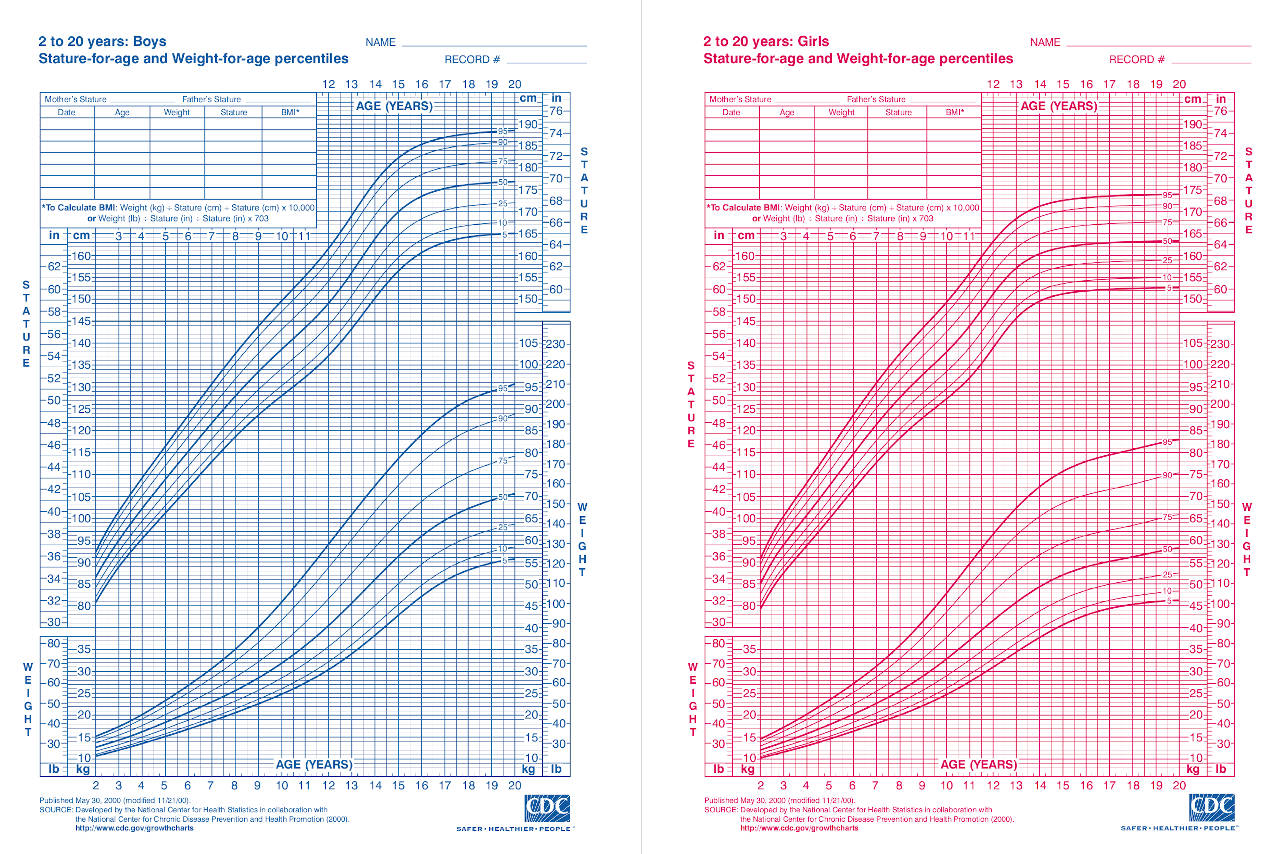Height Calculator
Predict the height of your child by entering the child’s height and weight and the height of the parents. This calculator considers the parent’s genetics and the child’s height and weight to estimate a child’s adult height.
Adult Height Prediction:
On this page:
How to Predict a Child’s Adult Height
There are several formulas available to help estimate a child’s adult height and stature, and they vary in accuracy.
Note that several factors throughout one’s life can play a role in just how tall a child gets – genetics, eating habits, illnesses, and medications can all affect the height of your child.

Child’s Height at Age 2 Method
By far, the easiest (and probably least accurate) way of predicting a child’s adult height is to double their height when they turn two years old. This is sometimes referred to as the “two years times two method.”
For example, if your two-year-old measures 29″, then this method would assume that their adult height would be approximately 58″.
Keep in mind that boys will often be slightly over this approximation, and girls will typically be slightly lower due to slight variances in growth rates. This method usually works because, at the age of two, children often reach their growth percentile that they will remain in as they continue to grow older.[1]
Mid-Parental Height Method
A slightly more sophisticated formula for predicting a child’s future height is called the mid-parental height method.
Height Prediction Formula
You can use the mid-parental height method formula to predict adult height like this:[2]
For Girls:
future height = (father’s height – 5) + mother’s height / 2
For Boys:
future height = (mother’s height + 5) + father’s height / 2
All measurements in these formulas should be in inches.
It’s important to note that the mid-parental height method has a margin of error of roughly four inches (10 cm), so it’s not considered an accurate way to determine future height.[3][4]
If you need to convert the child’s height from inches to centimeters or vice-versa, try our height converter.
Growth Charts Method
Another way to predict a child’s possible adult height is to use a growth chart such as one released by the CDC to predict how tall a child will grow.[5]
Growth charts compare a child’s height and weight with other children that are the same age and consider what percentile the child is in for height to estimate growth.
The growth charts below show the average height for males and females aged 2-20.

The growth charts illustrate the different growth rates between boys and girls. Males will notice a growth spurt later than females, since puberty is started at an earlier age in females.
Girls have a steady growth rate with a final growth spurt that peaks around age 11-1/2 and tapers off by age 16. On the other hand, boys have a steady growth rate and a final growth spurt that will spike around 13 years of age and tapers off by age 18 years of age.[6]
Bone Age Method
Yet another method for predicting height is to measure the bone age of the child. This method accounts for the variance in growth between children of the same age.
Since some children grow faster than others, and some stop growing sooner than others, measuring the child’s bone age may give a more accurate height prediction. By measuring the growth plates on the bones, a doctor can estimate their skeletal maturity, which is often different from the child’s actual age.
This method can be combined with the mid-parental height method to improve accuracy.[7]
The bone age method is generally preferred by pediatric surgeons who need to know approximately when a child will stop growing, especially if surgery is on the agenda. This method can be more complicated than some of the other methods for determining future height, since it requires taking x-rays of the wrist and hand to check the growth plates.[8]
The Khamis-Roche Method
The Khamis-Roche method for height approximation relies on scaling factors and other equations based on the child and parents’ height to make its final estimate. The Khamis-Roche method considers the child’s current height, weight, and age, and also the height of the parents.[9]
The Khamis-Roche method can possibly be useful for predicting the height of children with unusual stature for their age. Studies utilizing this particular method for height predictions have only tested using Caucasian children though, so accuracy might be skewed for other ethnicities.[10]
This method is only considered accurate for children over the age of 4.
This calculator uses the Khamis-Roche method for children over 4 and the Mid-Parental Height method for children under 4.
Every Child’s Growth is Different
Genetics play a major role in a child’s height and weight but do not completely determine how much a child will grow. Other factors, such as environmental input, nutrition, and overall health also contribute to a child’s final stature.
Some genetic conditions and endocrine disorders can also have an impact on growth. Homocystinuria, Marfan Syndrome, Simpson-Golabi-Behmel Syndrome, Beckwith-Wiedemann Syndrome, and Sotos Syndrome are examples of disorders of the metabolic system that can cause excessive growth.[11]
Other conditions, such as Down Syndrome, can cause a child’s growth to diminish over time; it’s noted that males with Down Syndrome are usually around 5’2, while females can reach 4’6 as adults.[12]
Diet and nutrition during development can also have a significant impact on growth and future height. Excessive nutrition at a young age can cause overgrowth and affect height; it can also contribute to obesity.
Every child is different and will develop differently as well. Some children stop growing sooner (or later) than others and experience growth spurts at slightly different ages.
Because of this, any prediction of a child’s height as an adult should be considered an estimate.
References
- Bishop, S., Child’s Height at Age 2 May Predict Adult Height, Mayo Clinic News Network, https://newsnetwork.mayoclinic.org/discussion/childs-height-at-age-2-may-predict-adult-height/
- Nwosu, B. and Lee, M., Evaluation of Short and Tall Stature in Children, American Family Physician, 2008, 78(5), https://www.aafp.org/pubs/afp/issues/2008/0901/p597.html
- American Academy of Pediatrics, Predicting a Child’s Adult Height, healthychildren.org, 1/27/2016, https://www.healthychildren.org/English/health-issues/conditions/Glands-Growth-Disorders/Pages/Predicting-a-Childs-Adult-Height.aspx
- Wright, C. M., Cheetham, T. D., The strengths and limitations of parental heights as a predictor of attained height, Archives of Disease in Childhood, 1999, 81(3), 257-260. https://adc.bmj.com/content/81/3/257
- Centers for Disease Control, Growth Charts, https://www.cdc.gov/GrowthCharts/
- MedlinePlus, Adolescent development, https://medlineplus.gov/ency/article/002003.htm
- Tanner, J., Whitehouse, R., Marshall, W., and Carter, B., Prediction of adult height from height, bone age, and occurrence of menarche, at ages 4 to 16 with allowance for midparent height., Arch Dis Child, 1975 Jan, 50(1), 14-26. https://www.ncbi.nlm.nih.gov/pmc/articles/PMC1544488/
- Hospital for Special Surgery, Is it Possible to Predict Height?, https://www.hss.edu/pediatrics-is-it-possible-to-predict-height.asp
- Laureys F., Middelbos L., Rommers N., De Waelle S., Coppens E., Mostaert M., Deconinck F.J.A., Lenoir M., The Effects of Age, Biological Maturation and Sex on the Development of Executive Functions in Adolescents, Frontiers in Physiology, 2021 Sep 10, 12, 703312. https://www.ncbi.nlm.nih.gov/pmc/articles/PMC8461056/
- Khamis, H., Roche, A., Predicting Adult Stature Without Using Skeletal Age: The Khamis-Roche Method, Pediatrics, Oct 1994, 94(4), 504-507. https://pediatrics.aappublications.org/content/94/4/504
- Urakami, T., Tall stature in children and adolescents, Minerva Pediatrics, 2020 Dec, 72(6), 472-483. https://pubmed.ncbi.nlm.nih.gov/32748612/
- Down Syndrome Association of Brazos Valley, Down Syndrome Facts, https://www.dsabv.org/resources__trashed/down-syndrome-facts/


